
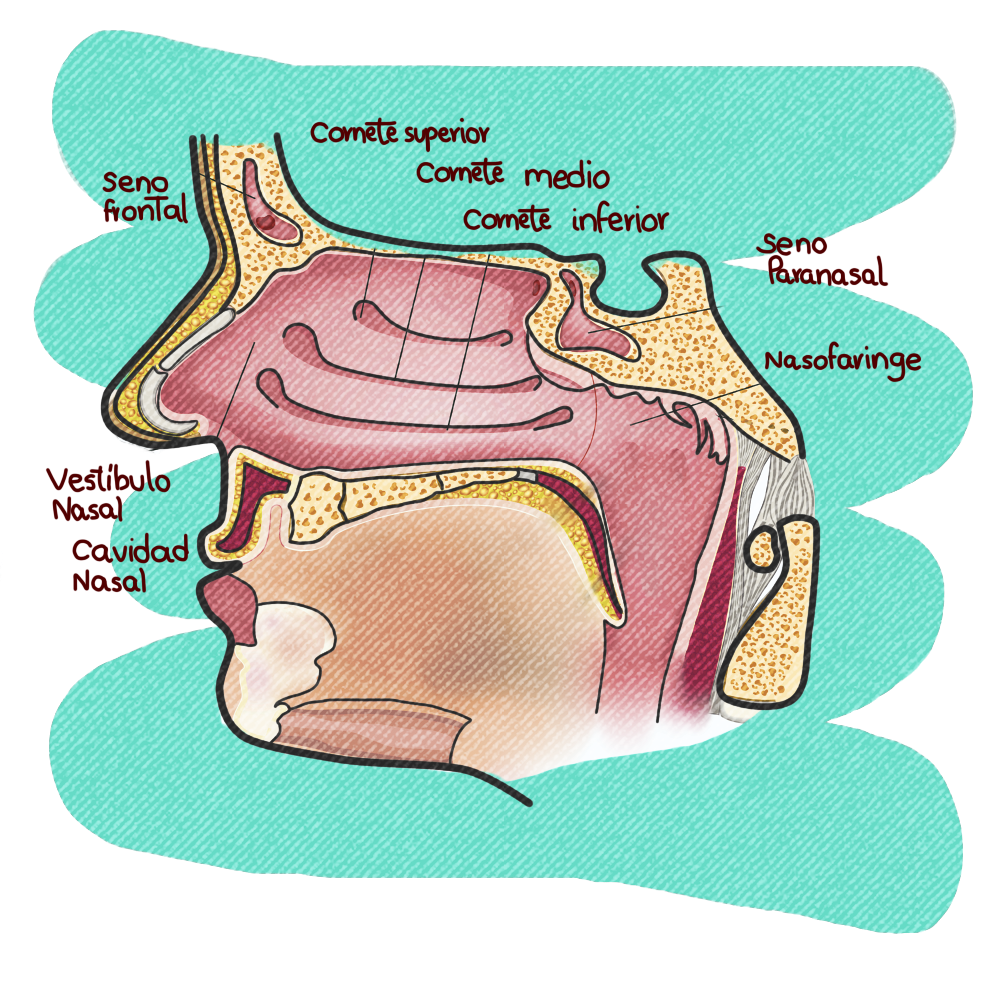
Las fosas nasales forman parte del aparato o también llamado como sistema respiratorio. En ésta publicación aprenderás acerca de las fosas nasales y que conexión tienen con el sistema respiratorio.
The nostrils are part of the apparatus or also called as the respiratory system. In this post, you will learn about the nasal passages and what connection they have with the respiratory system.

Las fosas nasales son dos cavidades óseas, esto significa que están hechas de huesos. Se encuentran separadas gracias a una pequeña estructura osteocartilogenosa llamada tabique nasal. Así mismo las fosas nasales comunican con el exterior, siendo así el tramo inicial del sistema respiratorio ya qué desde aquí comienza todo.
The nostrils are two bony cavities, this means that they are made of bones. They are separated by a small osteocartylogenic structure called the nasal septum. Likewise, the nostrils communicate with the outside, thus being the initial section of the respiratory system and from where everything begins.
¿Cuál es la función principal de las fosas nasales? / What is the main function of the nostrils?
Las fosas nasales o también llamadas como cavidad nasal, como ya se mencionó anteriormente comunican con el exterior y son el tramo inicial de todo el sistema respiratorio es por esto que sirven para la entrada y salida de aire, de igual manera constituyen de forma importante parte del sentido del olfato y su sistema.
The nostrils or also called as nasal cavity, as mentioned above communicate with the outside and are the initial section of the entire respiratory system that is why they serve for the entry and exit of air, in the same way they constitute an important part sense of smell and your system.
Comenzaremos explicando su anatomía. / We will begin by explaining its anatomy.
Ubicación:
En el humano podemos encontrar las fosas nasales ubicadas en el rostro, para ser más específicos en la nariz, la cuál viene siendo la parte superficial y anterior de las fosas nasales, se caracteriza por estar cubierta de piel y en su interior presentar tejido cartilaginoso como el tabique nasal. El resto de las fosas nasales se consigue en el interior del cráneo y por debajo de él.
Location:
In humans we can find the nostrils located on the face, to be more specific in the nose, which has been the superficial and anterior part of the nostrils, is characterized by being covered with skin and inside it presents cartilaginous tissue such as the nasal septum. The rest of the nostrils are found inside the skull and below it.
Narinas:
La parte que conecta con el exterior se le conoce como orificios nasales o narinas, es decir éste es el nombre que se le dan a los dos pequeños orificios de nuestra nariz.
Nostrils:
The part that connects with the outside is known as the nostrils or nostrils, that is, this is the name given to the two small holes in our nose.
Si nos adentramos a través de las narinas podremos encontrar un pequeño espacio denominado vestíbulo nasal, esto lo podemos llegar apreciar al momento de ver nuestra nariz por dentro.
If we go through the nostrils we can find a small space called the nasal vestibule, this we can appreciate when we see our nose from the inside.
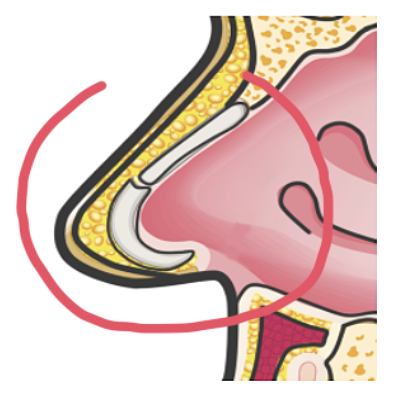
Vestíbulo nasal:
Es un pequeñito espacio ubicado en el interior de las narinas, viene siendo la parte más anterior de las fosas nasales, se encuentra cubierto por las capas de la piel. Dentro del vestíbulo nasal podemos encontrar unos pelos llamados vibrisas y una membrana mucosa.
Nasal vestibule:
It is a small space located inside the nostrils, it has been the most anterior part of the nostrils, it is covered by the layers of the skin. Inside the nasal vestibule we can find hairs called vibrissae and a mucous membrane.
Vibrisas o vello nasal:
Las vibrisas o vellos nasales cumplen con la función de filtrar pequeñas partículas que podemos arrastrar al momento de inhalar, un ejemplo muy claro de ésto puede ser el polvo, polen, esporas, virus y bacterias. Su función es evitar que lleguen a los pulmones y nos causen infecciones.
Whiskers or nasal hair:
The vibrissae or nasal hairs fulfill the function of filtering small particles that we can drag when inhaling, a very clear example of this can be dust, pollen, spores, viruses and bacteria. Its function is to prevent them from reaching the lungs and causing us infections.
Membrana mucosa nasal:
También conocida como mucosa es un tipo de tejido húmedo que se encarga de revestir el interior de la cavidad nasal, es húmeda y su función es filtrar y acondicionar el aire inhalado para que llegue en perfectas condiciones a nuestro organismo.
Nasal mucous membrane:
Also known as mucosa, it is a type of moist tissue that is responsible for lining the inside of the nasal cavity, it is moist and its function is to filter and condition the inhaled air so that it reaches our body in perfect condition.
Tabique nasal:
También se le conoce como pared media de la cavidad nasal, es una estructura de tejido osea y cartilaginoso que separa los orificios uno del otro
Nasal septum:
It is also known as the middle wall of the nasal cavity, it is a structure of bone and cartilaginous tissue that separates the holes from each other
Cornetes nasales:
Los cornetes también son conocidos como conchas nasales, son estructuras óseas divididas en una parte superior, media e inferior, se encuentran ubicados en las partes laterales de la cavidad nasal.
Nasal turbinates:
The turbinates are also known as nasal shells, they are bony structures divided into an upper, middle and lower part, they are located in the lateral parts of the nasal cavity.
Senos paranasales:
También llamados como senos nasales, son cavidades que se pueden encontrar en parte de los huesos del cráneo y de la cara, su función principal es la de aligerar el peso del mismo cráneo además de humidificar y calentar el aire que inhalamos.
Sinuses:
Also called nasal sinuses, they are cavities that can be found in part of the bones of the skull and the face, their main function is to lighten the weight of the skull itself as well as humidify and heat the air we inhale.
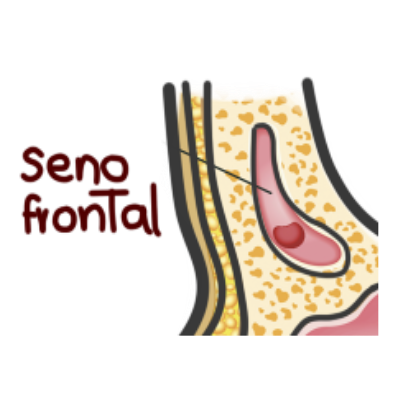
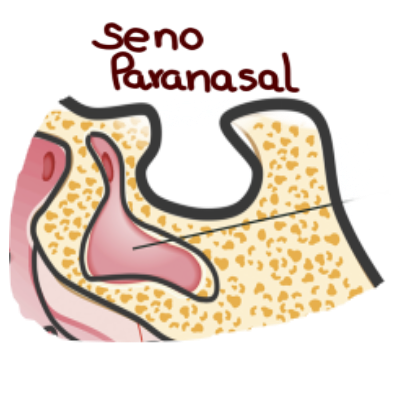
Los senos paranasales los podemos encontrar en los huesos del cráneo como el hueso frontal, esfenoides, etmoides y maxilar superior.
The paranasal sinuses can be found in the bones of the skull such as the frontal bone, sphenoid, ethmoid and upper jaw.
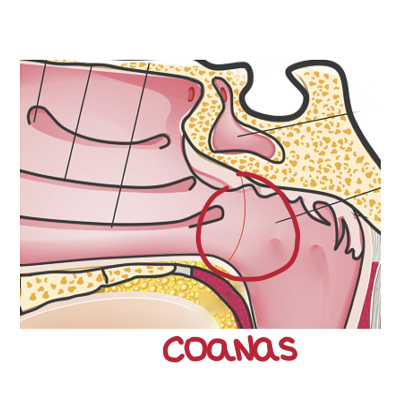
Coanas:
Son el límite posterior de las fosas nasales, desembocan en dos orificios llamados coanas y logran comunicar con la garganta, es decir logran conectar con lo que se conoce como rinofaringe o nasofaringe.
Choanas:
They are the posterior limit of the nostrils, they flow into two orifices called choanas and they manage to communicate with the throat, that is, they manage to connect with what is known as the nasopharynx or nasopharynx.
Gracias a la anatomía de la cavidad nasal el personal de salud puede descartar cualquier tipo de daño, de igual manera de pueden obtener diagnósticos gracias al estudio anatómico del mismo.
Thanks to the anatomy of the nasal cavity, health personnel can rule out any type of damage, in the same way they can obtain diagnoses thanks to its anatomical study.

Por esto mismo es importante que cada personal médico y de enfermería conozca acerca de anatomía.
For this reason it is important that each medical and nursing staff know about anatomy.

▪️ El separador que acabas de ver, es de mi autoridad.
▪️ Las imágenes que acabas de ver, son de mi autoridad.
▪️ The separator you just saw is from my authority.
▪️ The images you just saw are my authority.

Me gusta enseñar sobre las cosas que sé, y dar así un poquito de mi para ustedes, muchas gracias por leer, cualquier comentario o alguna duda que tengas será bien recibida.
I like to teach about the things I know, and thus give a little of myself to you, thank you very much for reading, any comments or questions you have will be well received.

Buenas, Su post ha sido propuesto para ser votado a lo largo del día por el witness @cervantes. Un saludo.
¡Gracias por el apoyo!